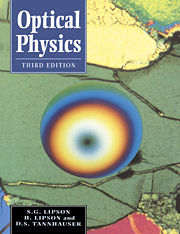Book contents
- Frontmatter
- Contents
- Preface to the third edition
- Preface to the second edition
- Preface to the first edition
- 1 History of ideas
- 2 Waves
- 3 Geometrical optics
- 4 Fourier theory
- 5 Electromagnetic waves
- 6 Polarization and anisotropic media
- 7 Diffraction
- 8 Fraunhofer diffraction and interference
- 9 Interferometry
- 10 Optical waveguides and modulated media
- 11 Coherence
- 12 Image formation
- 13 The classical theory of dispersion
- 14 Quantum optics and lasers
- 15 Problems
- Appendix 1 Bessel functions in wave optics
- Appendix 2 Lecture demonstrations in Fourier optics
- Bibliography
- Index
12 - Image formation
- Frontmatter
- Contents
- Preface to the third edition
- Preface to the second edition
- Preface to the first edition
- 1 History of ideas
- 2 Waves
- 3 Geometrical optics
- 4 Fourier theory
- 5 Electromagnetic waves
- 6 Polarization and anisotropic media
- 7 Diffraction
- 8 Fraunhofer diffraction and interference
- 9 Interferometry
- 10 Optical waveguides and modulated media
- 11 Coherence
- 12 Image formation
- 13 The classical theory of dispersion
- 14 Quantum optics and lasers
- 15 Problems
- Appendix 1 Bessel functions in wave optics
- Appendix 2 Lecture demonstrations in Fourier optics
- Bibliography
- Index
Summary
Introduction
Most optical systems are used for image formation. Apart from the pinhole camera, all image-forming optical instruments use lenses or mirrors whose properties, in terms of geometrical optics, have already been discussed in Chapter 3. But geometrical optics gives us no idea of any limitations of the capabilities of such instruments and indeed, until the work of Abbe in the middle of the nineteenth century, microscopists thought that the only limit to spatial resolution was their technical capability of grinding and polishing lenses. But (it now seems obvious) the basic scale is the wavelength of light, although recently several imaging methods have been devised which achieve resolution considerably in excess of this limit. The relationship is again like that between classical and quantum mechanics. Classical mechanics predicts no basic limitation to measurement accuracy; it arises in quantum mechanics in the form of the Heisenberg uncertainty principle.
This chapter describes the way in which wave optics are used to describe image formation by a single lens (and by extension, any optical system). The theory is based on Fraunhofer diffraction (Chapter 8) and leads naturally to an understanding of the limits to image quality and some of the ways of extending them.
The diffraction theory of image formation
In 1867 Abbe proposed a rather intuitive method of describing the image of a periodic object, which brought out clearly the limit to resolution and its relationship to the wavelength.
- Type
- Chapter
- Information
- Optical Physics , pp. 327 - 382Publisher: Cambridge University PressPrint publication year: 1995



